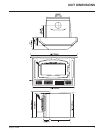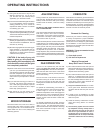
Regency I2400M 14
ASH DISPOSAL
During constant use, ashes should be removed
every few days. Please take care to prevent the
build-up of ash around the start-up air housing
located inside the fi rebox, under the loading
door lip.
DO NOT ALLOW ASHES TO BUILD UP TO
THE LOADING DOORS.
Only remove ashes when the fi re has died down.
Even then, expect to fi nd a few hot embers.
Always leave 1 to 2 inches of ash in the bottom
of the fi rebox. This helps in easier starting and
a more uniform burn of your fi re.
Ashes should be placed in a metal container with
a tight fi tting lid. The closed container of ashes
should be placed on a noncombustible fl oor or
on the ground, well away from all combustible
materials, pending fi nal disposal. If the ashes
are disposed of by burial in soil or otherwise
locally dispersed, they should be retained in the
closed container until all cinders have thoroughly
cooled. Other waste should not be placed in the
ash container.
Removal for Cleaning
Removal of your insert for cleaning purposes
is usually not required if a proper installation
has been done. In the event that removal is re-
quired, be sure not to damage any parts needed
for re-installation. In most cases removal and
replacement of the baffl e system should allow
full access for cleaning.
WARNING: Things to remember in case
of chimney fi re:
1) Close draft control
2) Call the Fire Department
Ways to Prevent and
Keep Unit Free of Creosote
1) Burn insert with draft control wide open for
about 45 minutes every morning during burn-
ing season. This helps to prevent creosote
deposits within the heating system.
2) Burn insert with draft control wide open for
about 10 - 15 minutes every time you add
fresh wood. This allows the wood to achieve
the charcoal stage faster and burns up any
wood vapors which might otherwise be
deposited within the system.
3) Only burn seasoned wood! Do not burn
wet or green wood. Seasoned wood that
has been dried at least one year must be
used.
4) A small hot fi re is preferable to a large
smouldering one that can deposit creosote
within the system.
5) Check the chimney at least twice a month
during the burning season for creosote
build-up.
6) Have chimney system and unit cleaned
by competent chimney sweeps twice a
year during the fi rst year of use and at
least once a year thereafter or when a
signifi cant layer of creosote has accu-
mulated (3mm / 1/8" or more) it should be
removed to reduce the risk of a chimney
fi re.
CREOSOTE
When wood is burned slowly, it produces tar and
other organic vapors, which form creosote when
combined with moisture. The creosote vapors
condense in the relatively cool chimney fl ue of a
slow-burning fi re. As a result, creosote residue
accumulates on the fl ue lining. When ignited, this
creosote can make an extremely hot fi re.
OPERATING INSTRUCTIONS
FAN OPERATION
The fan is to be operated only with the draft
control rod pulled out at least 1/2" from the
fully closed position. The fan is not to be oper-
ated when the draft control rod is in the closed
position (pushed in). The fully closed position is
the low burn setting.
The fan unit must not be turned on until a fi re
has been burning for at least 30 minutes and
the unit is hot enough. As well, after each fuel
loading the fan must be shut off until 30 minutes
has elapsed.
To operate fan automatically, push switch on
side of fan housing to "Auto" and second switch
to either "High" or "Low" for fan speed. The
automatic temperature sensor will engage the
blower when the unit is at temperature and will
shut off the blower once the fi re has gone out
and the unit has cooled to below a useful heat
output range.
To manually operate the fan system, push the
fi rst switch to "Man" and second switch to either
"high" or "Low". This will bypass the sensing
device and allow full control of the fan. Switching
from "Auto" to "Manual" or "High" to "Low" may
be done at any time.
9) During the fi rst few hours it may be more
diffi cult to start the fi re. As you dry out
your fi re brick and your masonry fl ue (if
applicable), your draft will increase.
10) For those units installed at higher elevations
or into sub-standard masonry fi replaces,
drafting problems may occur. Consult an
experienced dealer or mason on methods
of increasing your draft.
11) Some cracking and popping noises may be
experienced during the heating up process.
These noises will be minimal when your unit
reaches temperature.
12) Before opening your door to reload, open
draft fully for approximately 10 to 15 seconds
until fi re has been re-established. This will
minimize any smoking.
13) All fuel burning appliances consume oxygen
during operation. It is important that you
supply a source of fresh air to your unit
while burning. A slightly opened window is
suffi cient for this purpose.
CAUTION: If the body of your unit
starts to glow you are overfi ring.
Stop loading fuel immediately and
close the draft control until the glow
has completely subsided.
14) Green or wet wood is not recommended for
your unit. If you must add wet or green fuel,
open the draft control fully until all moisture
has been dispersed by the intense fi re.
Once all moisture has been removed, the
draft control may be adjusted to maintain
the fi re.
15) If you have been burning your insert on a
low draft, use caution when opening the
door. After opening the damper, open the
door a crack, and allow the fi re to adjust
before fully opening the door.
16) The controls of your unit should not be
altered to increase fi ring for any reason.
WOOD STORAGE
Store wood under cover, such as in a shed, or
covered with a tarp, plastic, tar paper, sheets
of scrap plywood etc., as uncovered wood can
absorb water from rain or snow, delaying the
seasoning process.


















